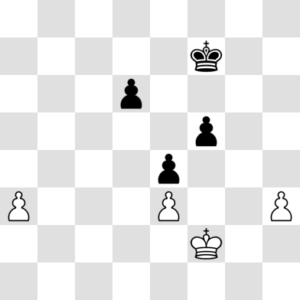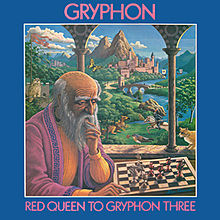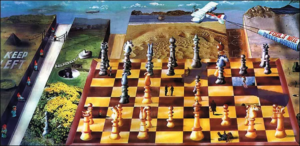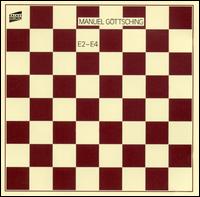A long time ago, I wrote a blog post about chess themed book covers, which greatly endangered my faith in humanity. A later post about absurd covers for a chess program proved fatal to it. A rare stroke of luck and probably the only reason that a third post featuring ridiculous positions used as cover art for actual chess books, for God’s sake, did no more damage. Today, we again venture forth in the dangerous world of cover art. This time, our subjects will be album covers from back when vinyl was the only way you could get music and there was a lot of space for delightful album art. Or disaster. The picture above comes from Wikipedia. It is the cover of:
Gryphon, Red queen to gryphon three, 1974
Apparently, this is classified as prog rock, but it stands head and shoulders above what I have heard in that genre before. It’s so refreshing to hear a bassoon solo in rock! The percussion is not always overdone! Some polyphony is attempted! The last movement has some flatterzunge passages! There are crumhorns!
The album art itself is quite pretty, too. I think it would be very good as cover art for the Heroes of might and magic series. But how about the chess? Well, both sides seem to have only two types of pieces left. The tall type must be the king. As each side has three of the smaller ones, they are probably pawns:1
 Hey, this is quite good, too! An endgame like this could very well arise in an actual game, although it seems likely that the pawn now on e3 came from f2. The bearded guy is probably checking his calculations to make sure black has no counter chances.
Hey, this is quite good, too! An endgame like this could very well arise in an actual game, although it seems likely that the pawn now on e3 came from f2. The bearded guy is probably checking his calculations to make sure black has no counter chances.
Realism: 4/5 I know of no actual game in which this position occurred, but apart from that this cover art seems very realistic!2
Probable winner: White. His king and e3 pawn can keep all black’s forces at bay while one of his flank pawns queens.
Peter Hammill, Fools mate, 19713
“Wait!” you scream at me in anger from a passing hot-air balloon, “That’s not the format of a vinyl!” Well, you’re wrong. It’s just one of those fancy covers where the image from the front continues on the spine and the back. I took the image from this site, which gives an interview with the designer.
But how about the music? Who is this Peter Hammill? Apparently, he started in another prog rock group, Van der Graaf generator, which is apparently famous. This is his solo debut.
On the chess front, things seem pretty straightforward. Clearly, 1. e4 e5 2. Bc4 Bb4 3. Qh5 Nf6 4. Qxf7# was played. A silly sequence of moves, of course, but one which on might see in a beginner’s game. But it’s not fool’s mate! If anything, it looks much more like scholar’s mate.
Realism: 4/5 This position has probably occurred in an actual game. A game between fools.
Probable winner: White, as he has mated. That does mean he keeps fools’ company, apparently.
Manuel Göttsching, E2-E4, 1984
By now, you don’t scream any more. Instead, you ask, rather befuddled, why on Earth I include this thing which is just a board without pieces. The answer is that two covers is a bit too little for a whole post, but that said blog is already quite long. So here is a third cover.
It’s hiding a record containing a single one hour long track by some guy I had never heard of, but who is apparently hugely famous in electronic music circles. The title is some kind of pun on a chord progression.
Realism: 0-5/5 If we consider this as a chess position, then obviously it is impossible. If we consider this as a possible look of an actual chess board, then it is very realistic. It’s more interesting than anything I can offer.
Probable winner: Whoever is going to play has the best chances.
1. [If you don’t like my diagrams, you can cover them yourself.] ↩
2. [Especially the gryphon!] ↩
3. [All sources seem to call this album Fool’s mate, but the apostrophe is just not there. I’m not sure whether this is a stupid oversight or an attempt at clever wordplay.] ↩


